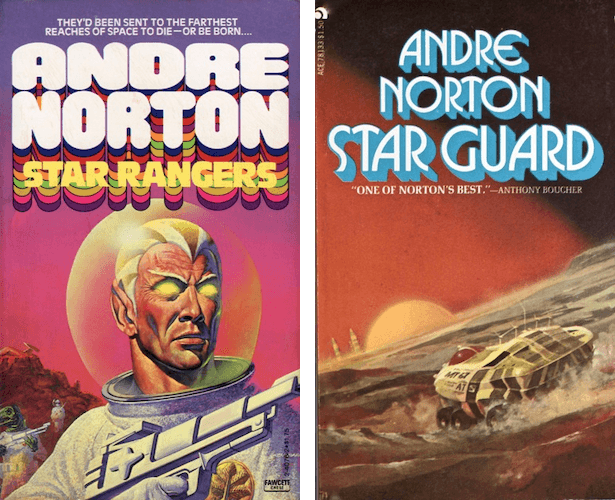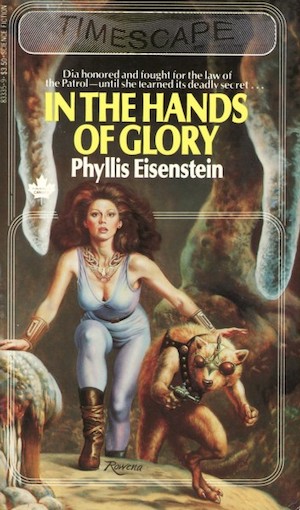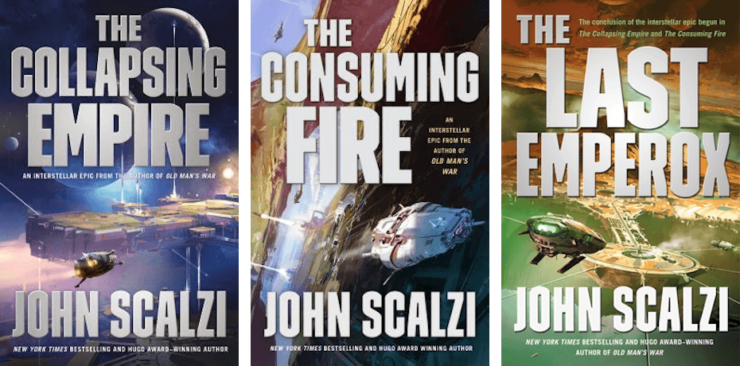One might think that if an organization/state/empire is big, it is too big to fail. Certainly, facing off against this kind of gargantuan foe always feels impossible in the here and now. But as we know… the bigger they are, the harder they fall.
This goes for star empires as well. Here are five empires that looked invincible and weren’t.
Andre Norton’s Central Control/First Galactic Empire

[Appears in at least two novels: Star Rangers (1953) and Star Guard (1955)]
Central Control managed to assimilate Terran barbarians in the 5th Millennium by steering worthy Terrans into appropriate occupations. When the Terrans displaced the races that formerly controlled the stars, Central prevailed: only rulers changed, but the empire carried on.
Until the 9th Millennium, that is, when the same historical forces that had destroyed previous empires brought the First Galactic Empire low. Regional governors sought power for themselves, bandits ran amok, and the Scout ship Starfire was dispatched on an errand straight out of Xenophon.
***
H. Beam Piper’s Federation

[Includes nine novels published over a span of thirty-two years: Uller Uprising (1952), Four-Day Planet (1961), Little Fuzzy (1962), The Cosmic Computer (1963), Space Viking (1963), The Other Human Race (1964, later released as Fuzzy Sapiens), Federation (1981), Empire (1981), and Fuzzies and Other People (1984)]
Forged in the aftermath of a global war that left Earth’s Northern Hemisphere in ruins, the Federation united first Earth, then the Solar System, and finally the stars across a vast volume of space. Although humans were not the only intelligent species in the region, they were by far the most technologically advanced. Thus, it was trivial for the Federation to dominate. Indeed, it had no external enemies (which didn’t stop it from constructing space fleets and weapons able to depopulate continents).
Unfortunately for the Federation, the novels were written by a staunch pessimist who didn’t believe any human organization was eternal. According to Piper, a major cause of the Federation’s downfall was economic: local economic development disrupted interstellar trade, which in turn led to strife, open conflict, and secession as various regions tried to shore up their economies. Ultimately, civil wars left the old Federation in ruins and too weak to resist predators like the Space Vikings.
***
Phyllis Eisenstein’s Stellar Federation

[In the Hands of Glory (1981)]
The Federation ruled over a century of peace—peace enforced by the Patrol. By pooling the resources of many worlds, the Federation could utilize the assets of its member planets to deal with any crisis that threatened a fellow member. At least in theory. Membership in the Congress of Planets gave all Federation planets a voice in shaping policy. Also in theory.
In practice, the Federation was defeated by something against which its resources were insufficient: the scale of a galaxy. Distances were too great and worlds too isolated for Federation response to be timely. Once the inherent intractability of governing a polity so vast became apparent, the Federation disbanded, leaving its former members to navigate the resulting chaos as best they could.
***
Walter Jon Williams’ Praxis Series

[Includes: The Praxis (2002), The Sundering (2003), Conventions of War (2005), The Accidental War (2018), Fleet Elements (2020)]
The alien Shaa conquered every system within a vast wormhole network. Because they enjoyed a considerable technological advantage over every other intelligent species, there was little other species could do aside from surrendering or dying horribly in futile resistance. Once crushed, each new conquest was reshaped into something pleasing to the one true Shaa way of doing things.
In fact, conquest and assimilation proved so routine that after millennia of success, the Shaa succumbed to species-wide ennui. Uninterested in maintaining their numbers, the Shaa population imploded. By the time of 2002’s The Praxis, there is but one Shaa left. Without the Shaa to guide them, what are the subject races to do? Why, turn on each other with fleets armed with horrific weapons and a total absence of any practical experience of war between equal foes…
***
John Scalzi’s The Interdependency

[Includes: The Collapsing Empire (2017), The Consuming Fire (2018) and The Last Emperox (2020)]
The Interdependency is based on cheap interstellar trade courtesy of the Flow, an enigmatic phenomena humans do not need to understand to pragmatically exploit. Trade is governed by economic guidelines that ensure that no single system is capable of surviving without goods and services imported from other systems. However individual worlds may feel about the interlocking network of monopolies that is the Interdependency, a declaration of independence is indistinguishable from suicide.
It’s just too bad that one of the core assumptions about the Flow—that it is stable on very long time scales—is wrong. The Flow is not stable and trade will soon become impossible. Whether worlds want independence or not—whether they can survive it or not—they will soon have it forced on them. Sweeping reforms are necessary. Too bad the Interdependency was designed to make reform well-nigh impossible.
***
No doubt I have missed many examples necessary to a proper foundation of this particular subgenre of speculative fiction. Please mention them in the comments below.
In the words of Wikipedia editor TexasAndroid, prolific book reviewer and perennial Darwin Award nominee James Davis Nicoll is of “questionable notability.” His work has appeared in Publishers Weekly and Romantic Times as well as on his own websites, James Nicoll Reviews and Young People Read Old SFF(where he is assisted by editor Karen Lofstrom and web person Adrienne L. Travis). He is a four-time finalist for the Best Fan Writer Hugo Award and is surprisingly flammable.











I can’t believe that you weren’t telegraphing this with your comment about a “proper foundation”. Asimov’s Empire, which was succeeded by his Foundation.
I can see a couple of recent examples of Empires ripe for fall in progress (SEVEN DEVILS by LR Lam and Elizabeth May, UNCONQUERABLE SUN by Kate Elliott and the Salvation series by Peter F Hamilton).
Correction: H. Beam Piper died in 1964. His Federation novels were *published* over a span of 32 years, but *written* over a span of 12 years (52-64).
Nicely written. There are many, many stories of failing empires. Most, with a few exceptions, have a common fault. The authors want to write about the interesting times around stellar empires collapse. They shorthand the reasons for the problems as equivalent to the Roman Empire and misunderstood history from Gibbon’s works.
Nothing wrong with that in a fictional world. But. It just gets as tiresome as space marines = USMC tropes.
The exceptions in my view were Poul Anderson’s tired Terran Empire, and Neil Asher having the Polity very well run and with instant communications.
The Roman Empire is a pretty good example of a failing empire. Rot from within destroying the empire from without. Add in some vicious enemies, and it’s a slow and painful death.
@3: Updated the language–thanks!
5: Alexis Gilliland had a couple of interesting collapses. In the Rosinante books, for example, it turned out the circumstances under which a North American Union made sense were short-lived, and that the heavy-handed methods used by the Contra Darwinist cabal running the NAU to enforce loyalty pissed off a lot more people than they intimidated. As soon as cracks appeared, the NAU dissolved like an extremely violent sugar cube in the rain.

In his The End of the Empire, the Holy Human Empire was (unsurprisingly) more like the Holy Roman Empire than the Roman Empire, a rather ramshackle accumulation run by not particularly bright people that held together until some bright person came up with a counter-measure for the technology on which the HHE military depended.
Piper was right; all empires fall eventually, nothing can be eternal, and that includes empires that do not consider themselves empires too.
@2. Paul: not sure Hamilton’s Salvation series has any empires in the traditional sense. There’s a religious crusade on the alien side, launched from their home system and a pocket dimension. They don’t acquire territory as much as collect bodies. And the humans have barely begun expanding outwards for a couple hundred years before they are forced to go on the run across the stars.
I was expecting Foundation and hoping for Praxis. One of two ain’t bad!
Traveller has an example (I would like to suggest “the Little Black Rule” as the name of “Traveller always has an example”): the First Imperium, whose technological stagnation, social stratification, atherosclerotic bureaucracy, and failure to explore just two more parsecs rimward led in just two centuries to its conquest by the upstarts of Terra.
(As for the Third Imperium, the assassination of Strephon never happened. And Virus most definitely never happened.)
James Blish was all about the cycles of history, with empires rising and falling while Cities were in Flight.
Piper had 2 Foundations followed by several Empires. Pournelle had his Co-Dominium followed by 2 empires.
In Doris Lessing’s “Canopus in Argos” series, the highly scientific Sirian Empire regards itself as at least the equal of the enlightened Canopeans. The Canopeans are polite enough to allow them this delusion. It is, nonetheless, a delusion, as books 3 and 5 very messily demonstrate….
Ha! I just reviewed Imperium a few weeks ago! It turns out at least one of my misapprehensions about Traveller come from playing Imperium.
James, do you recommend any of these? In general, when you do 5 books about toad-sexing or whatever, are they 5 books that you particularly recommend for people who are in the mood for reading toad-sexing stories, or are they just prominent examples, so any & all may be utterly dire?
These are all perfectly rereadable. Which is good because for the most part i have read and reread them all.
The empire in Ancillary Justice is just on the brink of starting to collapse.
I suspect that a lot of SF writers of a certain age who wrote of the rise and fall of interstellar empires were influenced by British historian Arnold J. Toynbee’s “cyclical theory.” Toynbee’s “A Study of History,” published in 12 volumes between 1934 and 1961, covering the rise, growth, decay and fall of civilizations, was enormously popular and influential at the time.
E.E. “Doc” Smith’s Lensmen world belongs on this list. Their galactic central government gets a ridiculous amount of money each year, so much so that if Kinnison didn’t want them go on this huge ship building spree, the govt. would have to lower taxes again, and they’re already close to 0%. Like, WTF? Now that’s a fantasy worth all the masters, a government who doesn’t run on debt.
@9
Piper mentions Toynbee’s influence in one of his stories. “Edge of the Knife “ I think
The “Emperor Undying” seems to have, um, died at the end of Harrow The Ninth. Presumably there was no succession plan, though I guess we have to wait for Alecto the Ninth to find out.
(Spoilers for a recent 2nd-in-a-trilogy published by Tor…)
Was expecting Weber’s Solarian League. Happy to settle for E.E. Smith instead.
Vernor Vinge’s A Fire Upon the Deep and A Deepness in the Sky have empires rising and falling, and civilization getting restarted after falls because ftl (?) spaceships preserve knowledge.
Bunch and Cole’s Sten series has an empire collapsing because of its Emperor’s increasing insanity. The Emperor’s supposed to be ‘eternal’ because every time he’s killed (always hushed up) he comes back within months. It doesn’t hurt that he and he alone controls the source of the super fuel ‘AM2″, without which the Empire simply cannot function.
Then one time he doesn’t come back until several years pass, and the Empire rapidly starts to fall apart. Then when he does come back, it quickly becomes apparent that this time the Emperor is Not Quite Right.
The Solarian League in David Weber’s Honor Harrington books was the largest, most powerful organization in the known universe … until it wasn’t.
I suspect that, even with FTL travel, the problem would not be the collapse of an interstellar empire, it would be getting one formed in the first place.
NancyLebovitz@24: The Qeng Ho were strictly STL, unless my memory is failing me really badly.
Must mention here (S.P.) Somtow (Sucharitkul)’s “High Inquest” series…
Keith Laumer’s Bolo setting, where the almighty Terran Concordiat starts a war with the Melconians, which escalated out of control to genocidal effect resulting in both sides being utterly destroyed aside from a bare few scrappy remnants and the odd unstoppable killing machine.
Hear, hear! On the matter of Traveller and The Virus.
Traveller actually offers the interesting views of “Empire too big the fail”, “Empire too big to succeed” and “Empire too stubborn to go away”, being the first, second, and third imperiums respectively.
31) And the first big thing about Traveller’s Imperium is it was surrounded by expansionist enemies. If it were to fall, or even have too severe a civil war, the surrounding polities would descend on it like vultures. There would be nothing left to form a new Imperium. Hence the Virus: they needed EVERYONE to suffer a collapse.
The second problem with the Imperium was that a civil war was inevitable. Given that it was run by an absolute dictator perched on top of a feudal system where messages took years to reach the borders, civil wars should have been happening on a regular basis, every three or four generations.
Wow! Maybe I misunderstood the precepts but for me, the singular works surrounding rising and falling empires were Herbert’s “Dune” series, Asimov, of course, and, perhaps, “The Expanse” which ultimately compares the dynamics of failing interplanetary governance to that of an extra-solar attempt at Empire. Heinlein tended to stick with “local” rebellions like the ones in “The Moon is a Harsh Mistress”, “Between Planets”, and “Revolt in 2100”.
It took about a decade for Ming the Merciless, Emperor of Mongo, to be overthrown. But that might’ve been because Flash Gordon & his rebels only appeared on Sundays.
The discussion wouldn’t be complete without listing Iain M. Banks’ Culture series. The Culture is a nearly-Galaxy-spanning civilization, comprising many races and machine minds, which owes its longevity to the presence of universal wealth due to advanced technology and to its emphasis on peace and individual freedom. Much of the stability of the Culture, which spans tens of thousands of yeats, is due to the benign influence of highly intelligent AI Minds.
Its seems to me that Dan Simmons’ Hyperion exactly fits the bill of an empire too big to fall and thus does.
@Tom C: the Culture never falls though. It’s actually stable and chooses to remain on this plane of existence, rather than Subliming/transcending to the next, because it wants to do good.
32) Exactly! I played Traveller for years and was bored stiff by the Imperium – the Virus and The New Era were (IMHO) necessary to shake things up. Even the folks at GDW said as much :)
@5, of course the Roman Empire did last until 1453. It died for a number of reasons, not least of which was a succession system that was a very bloody version of king-of-the-hill.
Fred Saberhagen’s Berserker books told the story of a couple of huge empires (or at least alien civilizations) that destroyed, not only each other, but most other species in the universe. (Not unlike Niven’s Slavers of his Known Space books.)
Of course, my favorite of his was the Empire of the East series, whose eponymous polity was too big to fail. That was great.
One of my favorites (despite its rather dated attitudes) is Poul Anderson’s Polesotechnic League/Terran Empire continuity: a trade empire, followed by a partial collapse, then a true Roman-style empire.
This may actually be more along the lines of an empire so big that it must inevitably fail, however.
And perhaps that’s the true theme of most of the series cited here.
In fact, on the eve of the Long Night, exacerbated by the Terran Empire’s cold war with the up and coming Merseian empire, it’s strongly implied that the Merseian polity has within it a similar rot and the seed of its own demise.
I believe this is precisely the description used for the Old Republic in Star Wars, by Alan Dean Foster.
qwibbian qwibbian kel
a tale you must not tell
#31/Robert – Interesting frames, the “Empire too big to fail,” “Empire too big to succeed,” and “Empire too stubborn to go away.”
#41/Mark – I think that Anderson’s Terran vs. Merseian empires fighting each other to mutual exhaustion was based on the ERE/Byzantines and the Persons/Sassanids; in one of the stories/novels where the protagonist is a diplomat/civil servant (not Flandry; Desai, maybe?) the parallel is included in the exposition.
Piper’s Federation to Empire cycle is interesting in that it is posited in a universe where there are not any peer powers/species to H. Sapiens; the break-up of the Federation(s) is essentially the result of civil war. He also had a story set late in the entire cycle where the monarch of the day sets up an undercover operation designed to simulate various “threats,” essentially to keep science and governance from defaulting to dogma … interesting take on the “to big to fail” concept.
Makes one wonder what happened to the Fuzzies and the Ullerans.
#45/James – Fair point. Piper had several sentient non-human species, but none that (in canon) developed space travel. The Ullerans managed to develop atomic weapons, but not in way that accomplished much for Uller … which sort of suggests how far Piper’s various “human/Terran/etc.” societies were prepared to let non-humans “go…”
Piper’s SPACE VIKING one of the very few books I have red more than once. Cheers!
The book where Fuzzies turn out to be extra-Zarathustran was by someone other than Piper, right?
Thanks for including Andre Norton on this list! Star Rangers is a classic example of her science fiction and, as you point out, is explicitly inspired by the tale of a Roman legion that marches into the East and is never heard from again. Several of her other SF novels are set during the collapse of an unnamed interstellar empire or federation (possibly the same one?) where conditions on planets are deteriorating, communication and trade are failing, and inhabitants are left to fend for themselves in an increasingly lawless galaxy. Surviving this breakdown of political order is a common theme in much of her work, where the protagonists must face both hostile humans and mysterious aliens bent on their own purposes. Often they’re living in the ruins of even older galactic empires whose fall left troves of artifacts (often buried in a cavern of some sort, because, well, Norton seemed to be into them).
@48 yes, before Fuzzies and other People had been discovered. It was Fuzzy Bones, by William Tuning.
I thought it did a pretty good job of tying up all the lose ends, at the cost of creating a big one.
Okay, how is it that Pournelle’s (or Niven & Pournelle’s) Co-Dominion and two successor empires did not make the list, or even any mention in the comments I can see until now?
By pure coincidence, I was looking from some “comfort food” reading last evening and picked Star Guard off my shelf. So, I need to pick a nit. That novel takes place in 3956 (2000 years after when it was written), which is 300 years after the CC takes over Earth. So that is happening in the 4th millenium, not the 5th.
And I would be remiss if I did not mention that Phyllis _hated_ the cover of In Hands of Glory. Besides the obvious, the woman has the wrong hair color.
Was there ever a second edition of the Eisenstein whose cover could be used in an upcoming review?
Thanks for mentioning some Walter Jon Williams. His Witness story in Wildcards is stunning. Tried Knight Moves after that and it was fine, but still not as tight as Witness (IMHO).
In the third book by Corey, they thank Walter Jon Williams for inspiration, actually for showing them “the way it is done” (or something to the same effect). I wonder if they were thinking about the Praxis series mentioned in this article?
The Empire prior to Muad’dib was said to have lasted for ten thousand years, which sounds a tad optimistic. Then of course we had the Sandworm Emperor for *another* ten thousand years.
And yet we never hear about the Noble Commonwealth idea save in the fixup books by Brian Herbert/Kevin J. Anderson, and we never hear about people softly, softly slipping away into parts of the galaxy where the Guild Navigators have no sway.
There are a number of series where I wonder why people don’t just leg it for somewhere far from the plot. The Praxis ships go pretty fast: why not run for a system without a wormhole, where the empire will never bother them? See also Karl Hanson’s extremely obscure War Games, where despite the Solar System being horrible, nobody ever used the insanely efficient space craft to just leave.
What happened to Civilization once Boskone was destroyed? Here’s this enormous, invincible, and rather chauvinistic Galactic Patrol, set up to fight a war, and suddenly there’s no one else to fight?
My Visualization of the Cosmic All says either the worlds fall on each other for lack of anything else, or the Patrol looks for someone else to fight, and finds it.
Since RPGs and related novels have been included, I’m surprised the rise, fall and/or decay is both the Aeldari and Imperium of Man from Warhammer 40,000 hasn’t been mentioned (even if in both cases there are some trying to reform them).
@james. As far as I know, there was just the one edition. Alex would know if there was another.
@18 Jamoche:
I’m not so sure about that as it seems more like a succession crisis. These occurred quite often in the lives of empires and kingdoms. These can be very risky for the empire or kingdom. Just ask, say, Harold about his difficulties ending in 1066.
@11 Then, GURPS Traveller is the Little Black Rule for Your 3rd Imperium?
@57,
The traditional behavior of imperial militaries when they’re no longer needed is to a) overthrow the civilian government b) find enemies to fight, preferably subversives, defined as anybody who says horrible things like “we don’t need to spend so much on the military.” The Lensmen would make quite sure that a enemy would continue to exist.
One of the reasons Costa Rica eliminated its military was because the military was the worst threat to national security. Judging by many South and Central American countries, they made the right call.
“The Lensmen would make quite sure that a enemy would continue to exist.”
Nope. The Lensmen are incorruptible by setting premise.
@@@@@ 19, Russel H:
I suspect that a lot of SF writers of a certain age who wrote of the rise and fall of interstellar empires were influenced by British historian Arnold J. Toynbee’s “cyclical theory.” Toynbee’s “A Study of History,” published in 12 volumes between 1934 and 1961, covering the rise, growth, decay and fall of civilizations, was enormously popular and influential at the time.
I loved Toynbee when I was a teenager.
I couldn’t even flirt with Spengler.
@@@@@ 44, Cdr. Bowman:
I think that Anderson’s Terran vs. Merseian empires fighting each other to mutual exhaustion was based on the ERE/Byzantines and the Persons/Sassanids; in one of the stories/novels where the protagonist is a diplomat/civil servant (not Flandry; Desai, maybe?) the parallel is included in the exposition.
Poul based the Flandry series on historical precedent. The emperors who succeeded Commodus (180 CE). They ranged from incompetent to mad. I’ve forgotten which ones Paul used as pattern-cards.
@@@@@ 56, James Davis Nicoll:
There are a number of series where I wonder why people don’t just leg it for somewhere far from the plot. The Praxis ships go pretty fast: why not run for a system without a wormhole, where the empire will never bother them? See also Karl Hanson’s extremely obscure War Games, where despite the Solar System being horrible, nobody ever used the insanely efficient space craft to just leave.
In The Rebel Worlds Flandry thwarts the mutinous Admiral Hugh McCormac. Who leads his people to settle far outside of the Terran Empire.
@64
H Beam Piper definitely used Toynbee as an inspiration. He also had a group of people head off for Parts Unknown who later return as the Space Vikings.